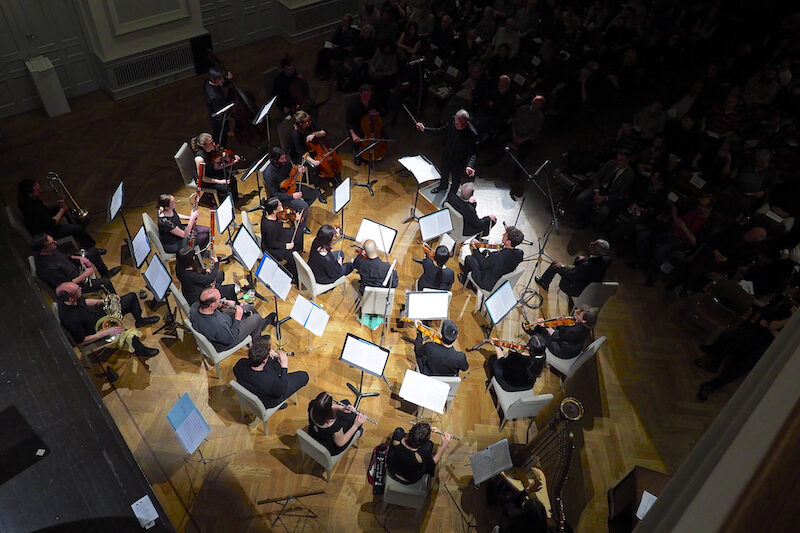2016-2017 Season
S.E.M. Ensemble's 2016-2017 season featured world premieres of works by composers such as Alvin Lucier, George Lewis, Roscoe Mitchell, Petr Bakla, Petr Kotik and Christian Wolff. The annual holiday concert at Paula Cooper Gallery was a highlight this season, as all of the pieces were electronic works. Below, find information on some of the concerts SEM performed in throughout the season.
Paula Cooper Gallery: October 11, 2016
S.E.M. Ensemble at Paula Cooper Gallery
Sol LeWitt Exhibition
534 W. 21st St. New York, NY
Tues. October 11, 2016, 8:00 pm
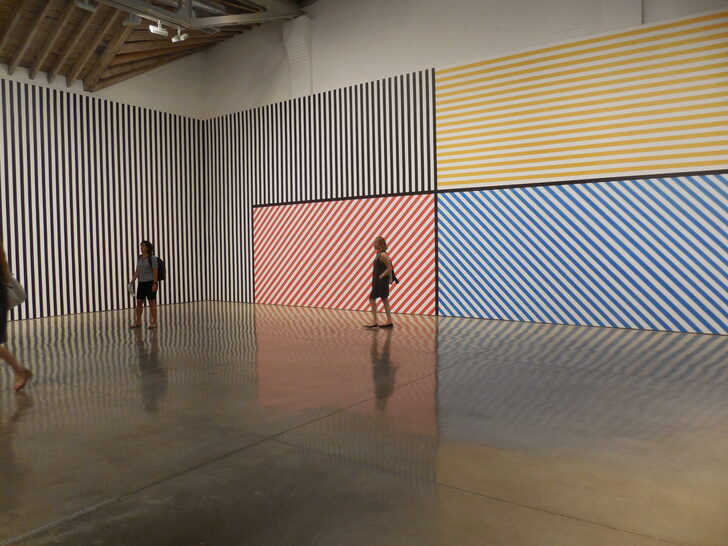
Sol LeWitt, Wall Drawing #368, Paula Cooper Gallery
Program
Petr Kotik: William William (2016) American premiere
Choreography by Matilda Sakamoto
Alvin Lucier: Navigations for Strings (1991)
Alvin Lucier: Love Song (2016) World premiere
S.E.M. Ensemble
Lucy Dhegrae, Soprano; Jake Ingbar, Baritone; Adrian Rosas, Bass;
Debra Kay Anderson, Narrator; Conrad Harris and Pauline Kim Harris, Violin;
Liuh-Wen Ting, Viola; Caleb van der Swaagh, Violoncello; John Altieri, Tuba
Petr Kotik, Conductor
Dancers
Matilda Sakamoto, Victor Lozano, Alex Andison, Connor Bormann
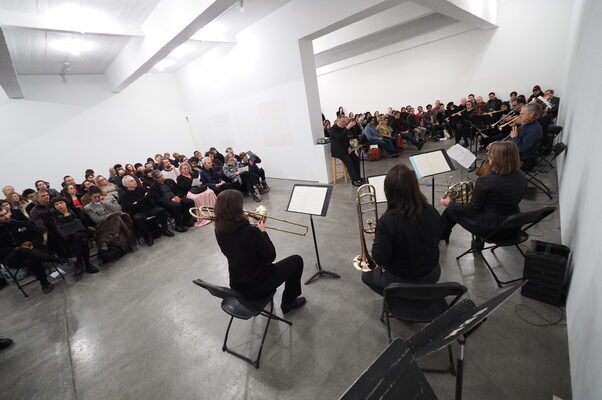
SEM at Paula Cooper Gallery, December 2015
I am delighted to present a concert during the Sol LeWitt exhibit. Although Sol and I never met, he has, since the 1980s, regularly supported SEM. The music we perform must have been the reason. More than often, our programs are not in line with the prevailing trends or popular taste of the moment. Together with other artists, composers, and music followers, LeWitt’s support gave us the encouragement to go forward, because one cannot do it alone. That is certain.
Every generation struggles with the impossible task to redefine its art, not for the sake of doing something new – that itself is not interesting. We have to redefine our work because using the means from the past is banal in the view of every day’s new reality. Nothing changes from generation to generation except composition (Gertrude Stein). The meaning of the work continues to be unabated, but the composition has to change as the world around us changes. When one paints, draws, or creates objects, listening is more important than looking. A composer on the other hand must shut his or her ears because for a composer, looking is more important than listening. This may be the reason why music and art have been close companions for generations.
The wall drawings by Sol LeWitt are case in point. They are closer to music than to the way we understand visual art. All the fundamentals of music composition are here in place: there is a score (i.e. instruction for the realization), there are performers (who execute the score), and there is duration for the piece to exist. What has been actually redefined here – art or music?
– Petr Kotik
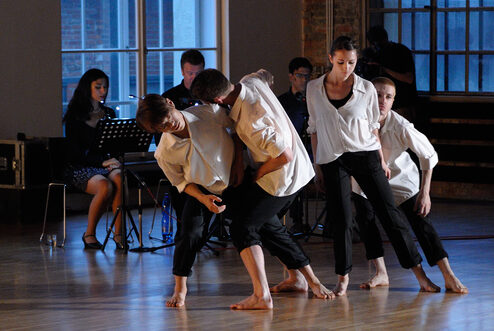
SEM and dancers perform Kotik's William William at NODO 2016, Ostrava, Czech Republic
I met Sol first through Andrea Miller-Keller who was his most eloquent and important friend and critic. Andrea suggested that Sol and I exchange works.
Sol was known for his ecumenical taste in art and had a huge collection of works by hundreds of artists. He gave me a wall drawing (#724) and I reciprocated with the hand written score of my quartet, Navigations for Strings. I was doubly honored that he later borrowed a panoramic photograph of part of the Swiss Alps that I had used in Panorama, a duo for piano and trombone, for Zug III, a gorgeous multi-colored wall drawing. More recently he asked me to supply music for his Curved Wall, an enormous sculpture first shown in Graz, Austria, later at Wesleyan. Sol LeWitt was the most kind and generous artist I have ever known.
– Alvin Lucier
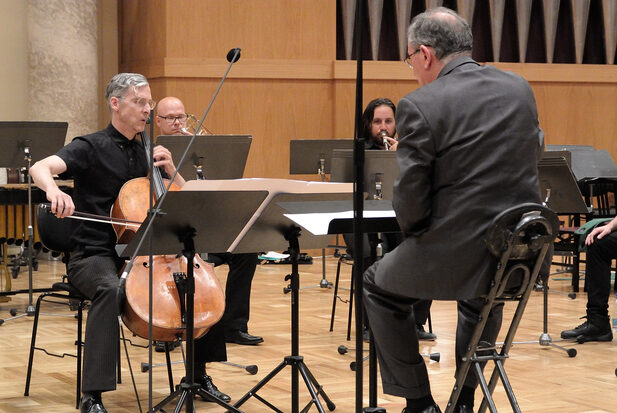
Kotik conducts the premiere of Lucier's Orpheus Variations, November, 2015
Musica Elettronica: December 9, 2016
The S.E.M. Ensemble presents its annual holiday concert:
Musica Elettronica
Stockhausen, Niblock, Kotik, Spiegel, Schumacher
at Paula Cooper Gallery, Mark di Suvero exhibition
534 W. 21st St. New York, NY
Friday, December 9, 8:00 pm
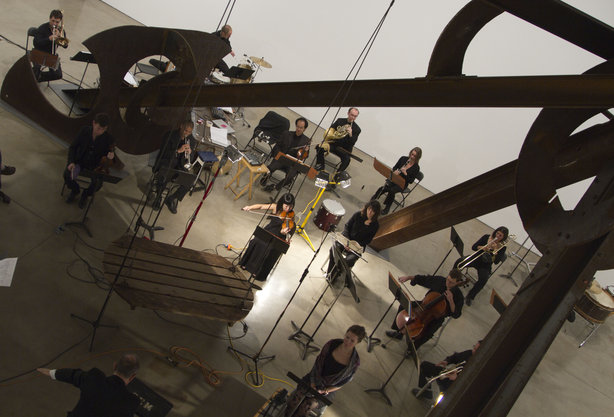
SEM at PCG, Mark di Suvero exhibit, 2011
Preview Concert:
Wed. Dec. 7 at 8 pm at Willow Place Auditorium
26 Willow Pl. Brooklyn Heights, NY
Free admission
Program
Phill Niblock: Praised Fan (2016) American premiere
Dafne Vicente-Sandoval, bassoon
Karlheinz Stockhausen: Gesang der Jünglinge (1956)
Petr Kotik: Kontrabandt (1967)
Michael J. Schumacher: Filters and Filtered (2011-present)
Laurie Spiegel: A Harmonic Algorithm (2011)
"SEM continues to play a critical role in New York's musical life."
- The Guardian, May 9, 2016
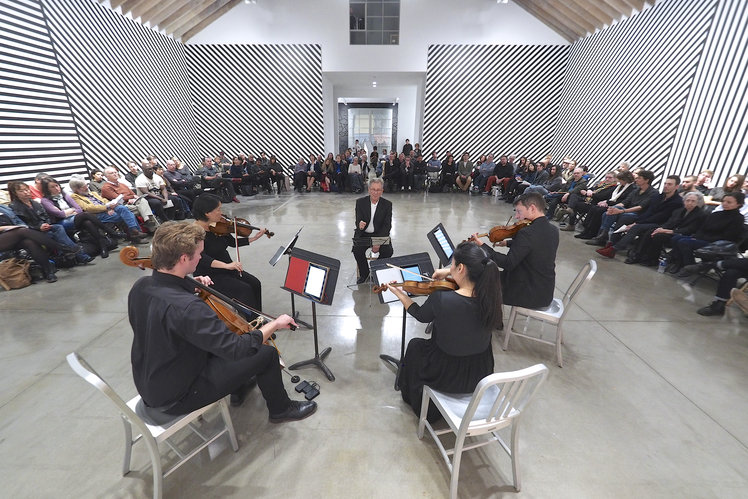
SEM at Paula Cooper Gallery, October 2016
Program Notes
Phill Niblock: Praised Fan (2016) – American premiere
This 17-minute work is based on microtonal variations around three pitches (G#, A, Bb), played in different octaves. These variations not only affect the pitch, but also the timbre and partial balance, and their layering creates complex melodies of overtones, as well as rhythmical patterns produced by tonal beatings. The work, commissioned by the Adelaide Festival in Australia, will be performed by French bassoonist Dafne Vicente-Sandoval.
Karlheinz Stockhausen: Gesang der Jünglinge ("Song of the Youths") (1956)
Hailed by many as the first masterpiece of electronic sounds, this 13-minute composition for magnetic tape and five loudspeakers integrates electronic sounds with the voice of a boy soprano singing fragments from the Book of Daniel. With it, Stockhausen tested and employed for the first time the idea of “music in space” that would finds its radical expression in Gruppen (1955-57). The work received its world premiere at West German Radio (WDR) in Cologne in 1956.
Petr Kotik: Kontrabandt (1967)
Petr Kotik met Stockhausen for the first time in the spring of 1965 when he visited the Studio for Electronic Music at WDR. In 1966 he received a commission from WDR to compose and realize a piece of electronic music. Scored for musicians and magnetic tape, Kontrabandt is a live electronic music work, in which performers manipulate sound sources, including 80 pre-recorded segments realized at the Studio for Electronic Music and ranging from a split second to one and a half minutes in duration. The work premiered in Cologne in 1967 as part of the WDR concert series “Musik der Zeit.”
Michael J. Schumacher: Filters and Filtered (2011-present)
Filters and Filtered is a 20-minute spatial sound installation originally composed for 8 channels and adapted to 4 for this performance. A "filter" is anything that comes between the transmission and reception of the signal, including equalization, bit reduction, wave-shaping, phase shifting, acoustic treatment, room resonance, masking, as well as other psycho-acoustic effects. The structure is derived from algorithms that combine elements of serial and aleatoric techniques. Filters and Filtered was presented in 14 channel versions at AVA Gallery in New York, iMAL in Brussels and at Ultraschall in Berlin.
Laurie Spiegel: A Harmonic Algorithm 2011
The work is the third incarnation of a computer algorithm that composes music first coded on Spiegel’s Apple II computer around 1980. Instead of creating a finite number of works, Spiegel had the idea to encode in computer software her personal compositional methods, and musical and aesthetic decisions so that new music could be composed and generated long after the biological human had ceased to exist. This particular software, based on the harmonic progressions of Bach’s chorales, merges Bach and Spiegel’s musical selves. The work was commissioned by the Barcelona Museum of Contemporary Art.
Bohemian National Hall: April 25, 2017
Press announcements: New Music World, New York Classical Review,
The New York Times, I Care If You Listen

SEM at Bohemian National Hall, May 2016
The Orchestra of the S.E.M. Ensemble
Petr Kotik, conductor
with soloists
Muhal Richard Abrams, piano
Roscoe Mitchell, saxophone
George Lewis, trombone
Thomas Buckner, voice
Joseph Kubera, piano
Dana Jessen, bassoon
Claire Chase, flute
and special guests
Momenta Quartet
The Orchestra of the S.E.M. Ensemble, founded and directed by Petr Kotik, presents a marathon program which uniquely combines composers from the Association for the Advancement of Creative Musicians (AACM) – Muhal Richard Abrams, George Lewis, and Roscoe Mitchell – with those associated with the New York avant-garde tradition – Christian Wolff, Petr Kotik, Jackson Mac Low, and Czech composer Petr Bakla. SEM’s collaboration with AACM began 20 years ago, when Muhal Richard Abrams invited Kotik and his orchestra to perform, and has continued until today with many commissions and recordings. The concert’s program aims to bring forth the proximity of different musical ideas and underlines Kotik’s openness to unorthodox combinations of composers, whose work he has presented at SEM concerts in New York, and in Europe at the Ostrava Days festival.

(L-R) Petr Kotik, Chris Nappi, Dick Higgins, Joe Kubera, Jackson Mac Low, and Anne Tardos perform at S.E.M. Ensemble's Spoken Music concert at Paula Cooper Gallery, 1990
PROGRAM:
George Lewis - Emergent (2014)
Claire Chase (flute) and 4-channel sound
Muhal Richard Abrams - Trio Things (2016)
Abrams (piano), Tom Chiu (violin), Meaghan Burke (cello)
I n t e r m i s s i o n
Jackson Mac Low - Is That Wool Hat My Hat? (1980)
4 Narrators
Christian Wolff - Five Songs (2017) WORLD PREMIERE
Thomas Buckner (voice) and orchestra
Petr Kotik - Music for 3 (1964)
Stephanie Griffin (viola), Meaghan Burke (cello), James Ilgenfritz (bass)
Roscoe Mitchell - Distant Radio Transmission (2017) WORLD PREMIERE
Mitchell (saxophone), Buckner (voice), and orchestra
I n t e r m i s s i o n
Petr Bakla - Major Thirds (2017) WORLD PREMIERE
Joseph Kubera (piano), Momenta Quartet
George Lewis - Seismologic (2017) WORLD PREMIERE
Dana Jessen (bassoon) and 4-channel sound
Group improvisation - Roscoe Mitchell, George Lewis, Thomas Buckner, Joseph Kubera, Sara Schoenbeck

(L-R) Chris Nappi, Roscoe Mitchell, Sara Schoenbeck, Thomas Buckner, James Ilgenfritz, Lucie Vitkova, and George Lewis at Bohemian National Hall, May, 2016
Voices and instruments: JUNE 20, 2017
Voices and Instruments
The Music of Petr Kotik and Friends
Tues. June 20, 2017, 7 pm
- at -
Willow Place Auditorium, 26 Willow Pl., Brooklyn Heights

SEM performs Many Many Women at Paula Cooper Gallery, 2013
S.E.M. Ensemble
Petr Kotik - Artistic Director
Roberta Michel, Petr Kotik - Flute
Jacqueline Leclair - Oboe
William Lang, James Rogers - Trombone
Robert Boston - Keyboard
Kamala Sankaram, Vivian Yau - Soprano
Jacob Ingbar, Jeffrey Gavett - Baritone
Program
Petr Kotik - Etude 7 for Oboe (1962)
Philip Glass - Two Pages (1968)
Petr Kotik - There is Singularly Nothing (1972)
Petr Kotik - Many Many Women (1975-78) [excerpt]
(le) poisson rouge: JUNE 21, 2017
Nothing / Everything Changes: Petr Kotik @ 75
with special guests Philip Glass, George Lewis, and Alex Mincek
(Le) Poisson Rouge
158 Bleecker St, New York, NY 10012
Wednesday, June 21, 6:30 pm
The S.E.M. Ensemble
Petr Kotik, conductor
with
Momenta Quartet
and soloist
Jacqueline Leclair, oboe
(le) poisson rouge commemorates the birthday of Petr Kotik along with friends Philip Glass, George Lewis, and Alex Mincek in conversation and a retrospective performance of Kotik’s iconic works, along with early music by Glass and an improvisation by Lewis and Mincek. A screening of the new film Untamable Kotik, produced by Czech Television will precede the concert. The performance will run 90 minutes without intermission and will be moderated by Pauline Kim Harris.

6:30pm - Untamable Kotik
A new film by Czech Television (the national public television network), Untamable Kotik documents Kotik’s performances, rehearsals, travel, and personal life. Switching back and forth between New York, Prague, and Ostrava, it was filmed in the period between 2015 and 2016. It includes musicians from both continents in rehearsals, performances, and conversations. The film features music by Kotik, Phill Niblock, and John Cage. It is in English and Czech w/ English subtitles. Philip Glass, George Lewis, Alex Mincek, and Petr Kotik will be present throughout the evening to comment.
7:30pm - Music and talk
Featuring Jacqueline Leclair, oboe, S.E.M. Ensemble, and Momenta Quartet
Program:
Petr Kotik - Etude 7 for Oboe (1962)
Philip Glass - Two Pages (1968)
Petr Kotik - There is Singularly Nothing (1972)
Petr Kotik - Many Many Women (1975-78)
George Lewis - Interactive Trio – short improvisation for trombone, saxophone, and computer-controlled Disklavier
Petr Kotik - Torso – 2nd String quartet (2013)
